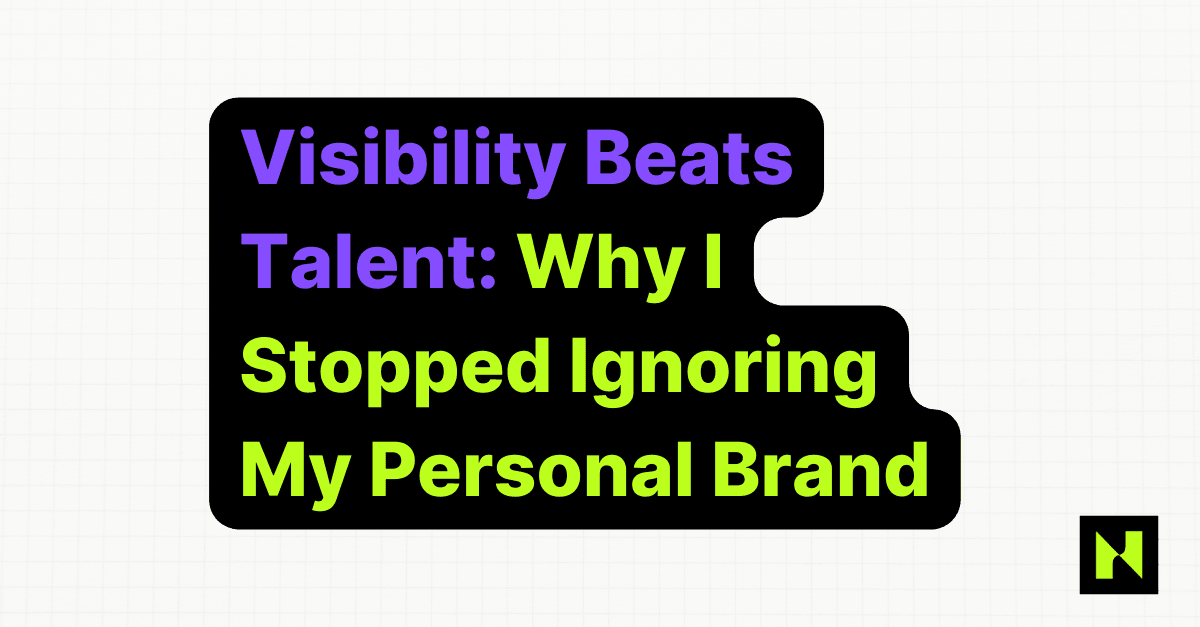Let me admit something upfront: I used to cringe at the idea of “personal branding.”
In fact, I’ve come to realize that Visibility Beats Talent, especially in a crowded marketplace.
When I first started writing online, it felt awkward. I wasn’t used to putting my thoughts out there. Video content? Forget it. I hated the sound of my own voice, let alone the thought of recording myself. Writing, though, that was my safe space. I could sit down, think, and express myself without feeling like I was forcing it.
This key insight -Visibility Beats Talent, has driven me to embrace my personal brand.
But here’s the hard truth I learned as a founder: If you’re not visible, you’re invisible. And if you’re invisible, opportunities pass you by.
Visibility isn’t ego. It’s leverage.
Why Founders Struggle With “Branding”
When you’re building your first business, you already feel stretched. Sales, product, customers, team, there’s barely time to breathe. Adding “branding yourself” on top of that feels indulgent, even unnecessary.
I told myself the same thing: “My work should speak for itself.”
But the market doesn’t work that way anymore. According to a LinkedIn study, 79% of buyers say thought leadership directly influences whether they trust a company or executive before making a decision.
In other words, if people can’t see your work, they won’t believe in your work.
What Executive Branding Actually Means
Let me strip away the buzzwords.
Executive (or founder) branding isn’t about looking good on camera, posting selfies, or writing motivational quotes. It’s about building a clear, authentic, and searchable presence that reflects your value as a leader.
Think of it like this:
- A potential customer Googles you.
- An investor checks your LinkedIn.
- A partner stumbles on your Twitter.
What do they see? If it’s an empty profile or outdated info, they move on.
Your brand is your first impression. And in 2025, first impressions happen online.
My Early Struggles (And How I’m Pushing Through)
When I started putting myself out there, it was awkward:
- Writing online felt like shouting into a void.
- I second-guessed every sentence: “Does this sound smart enough?”
- I avoided video (I still do) because I thought I’d look unpolished.
The breakthrough came when I reframed branding not as “promotion,” but as documentation.
Instead of trying to sound perfect, I started writing what I was learning, mistakes, wins, frameworks. Suddenly, it wasn’t about me. It was about helping the next founder avoid the same mistakes.
That’s why I doubled down on Twitter and LinkedIn. Writing is where I feel natural. And the more I write, the less cringe it feels.
Visibility = Opportunity
Here’s what happens when you invest in your visibility:
- You gain credibility immediately. People trust what they can see and verify.
- You create leverage. You stop being “just another founder” and start being seen as someone worth listening to.
- You open doors. Speaking gigs, collaborations, consulting, even investors, they all start with visibility.
- You differentiate. In a crowded market, being good isn’t enough. You have to be known.
I’ve seen it first-hand. Some of my best opportunities didn’t come from pitching. They came because someone had already been reading my work for months.
That’s the ROI of showing up.
A Simple Framework to Start Branding Without Cringe
If you’re a first-time founder like me, here’s how you can ease into branding without feeling like you’re faking it:
Step 1: Pick your medium.
If you love writing, start with LinkedIn posts or Twitter threads. If you’re great on video, try short-form clips. Don’t force a channel that doesn’t fit.
Step 2: Document, don’t perform.
Share lessons, mistakes, and thought processes. Write like you’re talking to one founder friend.
Step 3: Refresh your digital footprint.
Update your LinkedIn, clean up your bio, and make sure your first impression online matches where you are now, not five years ago.
Step 4: Show up consistently.
One post a week beats one viral post and silence. Visibility compounds. (I have challenged myself to write one post a day.)
Step 5: Tie it back to your business.
Make sure your personal brand ladders up to your company’s mission. When people trust you, they’ll trust what you’re building.
Branding Is Strategy, Not Vanity
I’ll be honest, I’m still working on this myself. I still hesitate before hitting “post.” I still prefer writing over video. But I’ve stopped seeing branding as something cringe, and started seeing it as a responsibility.
If you’re building something that matters, you owe it to yourself, and to the people who could benefit from it, to be visible.
Because the biggest risk isn’t being judged. The biggest risk is being overlooked.
So here’s my challenge to you: This week, publish one piece of content. A tweet, a LinkedIn post, even a short note about what you’re learning. Start small, but start visible.
That’s not vanity. That’s strategy.





